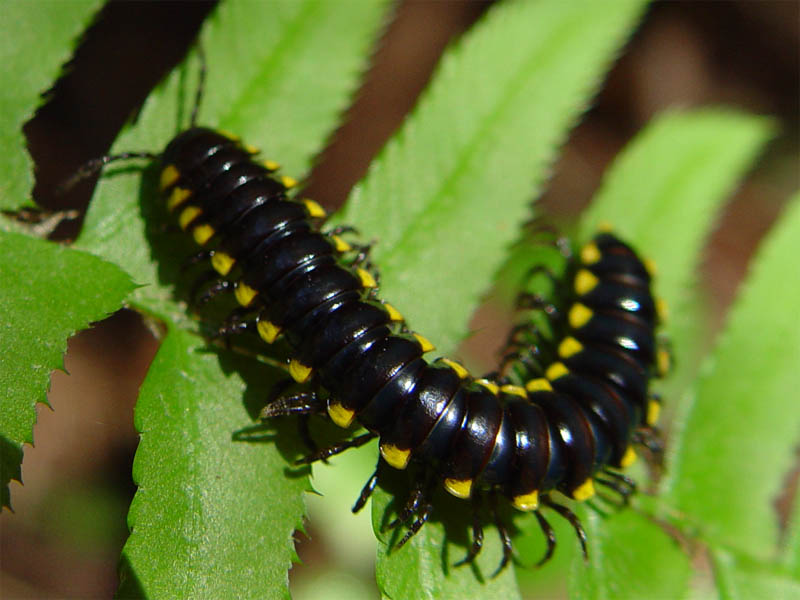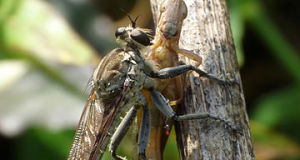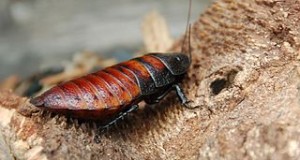Hello, Frank Indiviglio here. Please see Part I of this article for my “close call” with some cyanide-producing millipedes.
Millipede Generated Cyanide and Poison Frogs
 It seems that millipedes of many types (there are over 10,000 species described to date) mix hydrogen cyanide, quinones, phenols and aldehydes with enzymes to create toxic defensive sprays and secretions. In fact, tiny millipedes consumed by poison frogs (Dendrobates spp.) account for some if not most of the virulent skin toxins found in the skins of these colorful amphibians.
It seems that millipedes of many types (there are over 10,000 species described to date) mix hydrogen cyanide, quinones, phenols and aldehydes with enzymes to create toxic defensive sprays and secretions. In fact, tiny millipedes consumed by poison frogs (Dendrobates spp.) account for some if not most of the virulent skin toxins found in the skins of these colorful amphibians.
Much like the frogs, millipedes seem to obtain at least some defensive chemicals from their diet. As is true with poison frogs and related species, the toxicity of the millipedes’ secretions decreases over time when they consume captive diets.
Monkeys and People Draft Millipedes to Battle Pests
The monkeys studied by my friend (please see Part I) were using the millipedes as a mosquito and parasite repellent. The millipedes seemed quite valuable to the monkeys – so much so that the normally arboreal primates left the safety of the tress to retrieve any millipedes that had been accidentally dropped.
Certain millipede secretions also have antibacterial properties, and are being investigated for medicinal use…it is not known if monkeys exploit this aspect of the toxins as well.
Millipedes as Pets
Millipede secretions can irritate our skin, mucus membranes and eyes, so I always caution people to handle them with gloves and  to keep the animals away from one’s face. Stressed millipedes confined in airtight containers have been known to expire from the concentrated effects of their own toxins.
to keep the animals away from one’s face. Stressed millipedes confined in airtight containers have been known to expire from the concentrated effects of their own toxins.
That being said, millipedes make extremely interesting terrarium subjects, and a number breed well in captivity. Next time I’ll cover the care of a few regularly available species.
Further Reading
Millipedes have other defensive tricks as well. A tiny millipede native to Florida uses detachable bristles to disable ants and other predators. Read more here.
Until then, please write in with your questions and comments.
Thanks,
Frank Indiviglio
Harapahe haydeniana image referenced from wikipedia and originally posted by Folini
Millipede image referenced from wikipedia and originally posted by Esculapio
 That Reptile Blog – Reptile, Amphibian and Exotic Pet Care and Information
That Reptile Blog – Reptile, Amphibian and Exotic Pet Care and Information



Hi Frank,
I am from Singapore and I saw your blog on the millipede that generates cyanide which is similar to what my problem is now.
These millipedes doesn’t exist in our yard until a couple of years ago and to date its propagation has gone out of control and they are invading into our dwelling area. We have no wish to destroy this millipedes but the growth rate was uncontrollable and their ‘nest’ can be found almost everywhere in our compound.
Help. I need some advise on how to contain my situation with these millipedes.
Hello Mike, Frank Indiviglio here.
Thanks for your interest in our blog. Unfortunately, there are a great many species of millipede in your region; insecticides/poisons work on some types but not others. If you want to control them with chemicals, you’d need to contact a pest control business locally, so that they can identify the species.
Millipedes need a moist environment. In small areas, i.e. a room, a dehumidifier, to remove moisture from the air, can be very effective – millipedes entering from outdoors will not survive for long.
Also in small areas, they can be lured into a jar or cam baited with banana soaked in beer or other fruit (most species)…but it’s difficult to control there numbers in this way, and you may wind up catching other invertebrates and luring fruit flies into the home as well.
Sorry I could not be of more assistance…
Good luck and please keep me posted.
Best regards, Frank Indiviglio.
Hi Frank,
After months of periodical trying, we have been unsuccessful in getting rid of the millipedes. The millipedes look exactly as what you have pictured here on your blog. At one point, the millipedes almost reach epidemic proportion. They keep invading our dwelling areas.
We did dug out one of the suspected ‘nest’ in the garden and found hundreds of them within the soil. This is really disturbing. In recent weeks, the millepedes has ‘tone down’ a little but it is still a nuisance as they will be accidentally stepped on, and to make matter worst they gives off a pungent smell.
Hope get some advise on how to get rid of them in larger scale. I am not fond of pesticide as we have cats and dogs around, and of course children.
Thank you, Frank.
Mike
Hello Mike, Frank Indiviglio here.
Thanks for the update. I’m sorry to say I’ve not been able to come up with much. Native species here in the US show up in pitfall traps (cans sunk level with the ground) baited with banana, but I don’t imagine trapping would be practical considering the population size you describe. I’m writing to a colleague of mine at the Am. Museum of Natural History; he may have some insights. I’ll keep your email and write back when I hear from him.
Good luck and please keep me posted.
Best regards, Frank Indiviglio.
Thank you Frank. These creepy crawlies are getting on our nerves 🙁 Will be waiting to hear from you.
Best regards,
Mike
HI,
This species harpaphe haydeniana (Polydismida) is propogating on my lawn. Any solution to control them. Ive tried to reduce watering unfortunately the grass is drying off..There are millions waiting beneath them….Its ” Mummy Returns”
thanks
Hi,
They adapt well to dry conditions, moving deeper into the soil or becoming dormant, so indeed grass would die off long before the millipedes. For that size population you’ll need a professional exterminator; however, because of the hard exoskeleton and burrowing lifestyle, they are difficult to control with pesticides.
Sorry I could not be of more help, Best, Frank
hi Shiva and Frank,
it has been more than two years since the problem with this millipedes and sadly, it hasn’t go away. we thought they are gone for good a year ago but just six months ago, they made a come back. we lace pesticide along the path that they took along the house and we probably kill hundred of thousands of them and still more are coming up each day. it is rainy season here and we thought it might be the water soaked soil underground that drives them back up. i am really lost.
Hi Mike,
Thanks for the update; their reproductive potential is amazing, and most species can wait out bad weather and so on, so they are very hard to control. No real studies I know of re their developing resistance to pesticides, but just about every invertebrate studied does, so that is another consideration.
Thanks for the interesting dialog, sorry I cannot offer any useful answers, Best, Frank
No worries Frank. Nice conversing with you.
We are contemplating to drop the pesticide to the soil but was afraid that we might screw up the natural water source. that is the hardest part of this issue.
Yes. These millipedes are reproducing extremely quickly and made worst by the fact they are not native here thus, no natural predator to feast on them.
We share monitor and see how it goes. Once again, thanks Frank!
Thanks for the info, Mike. Look forward to hearing updates, Frank
Hello,
I was just wondering, how much hydrogen cyanide that a rusty millipede (Trigoniulus corallinus) can produce. Is it safe if someone accidentally consume it? I heard that hydrogen cyanide is a deadly poison.
Hello,
I cannot locate anything published on the toxicity of this species. A doctor should be consulted in the event of accidental ingestion. I hope all goes well, Frank